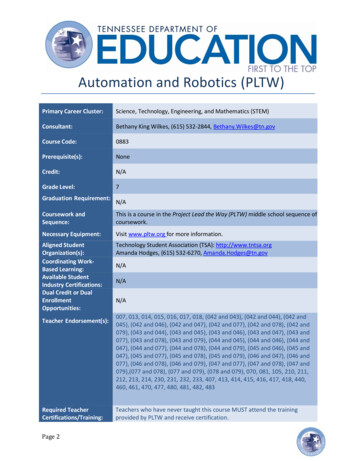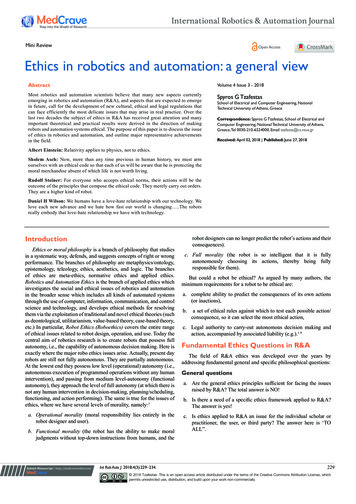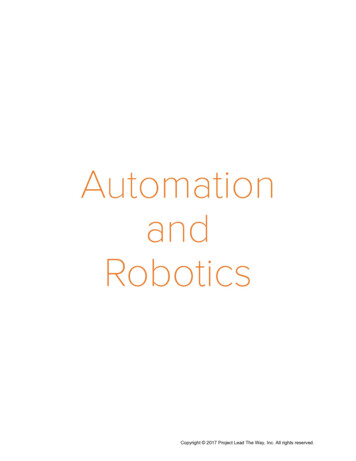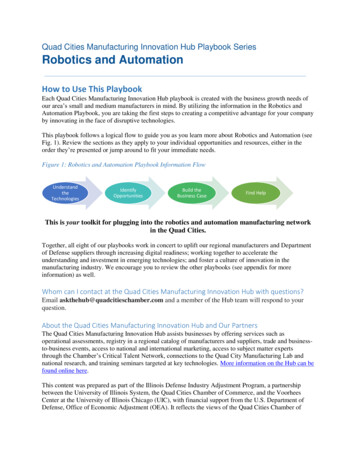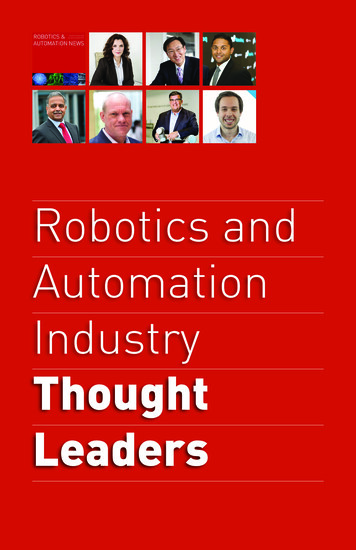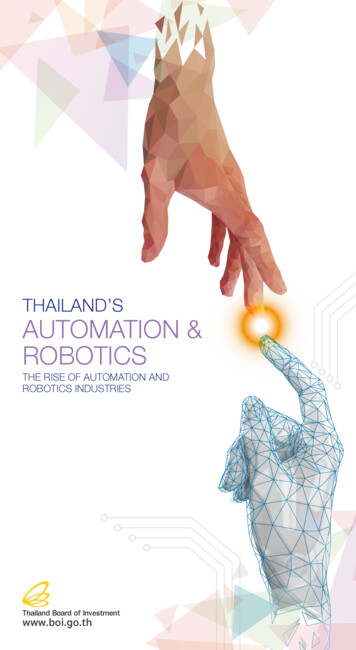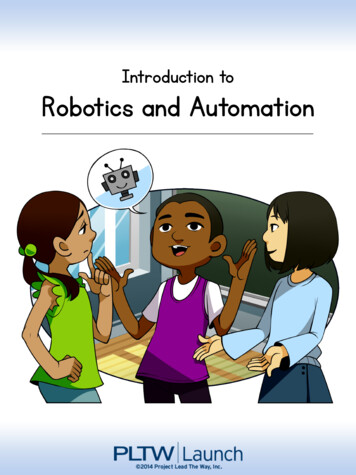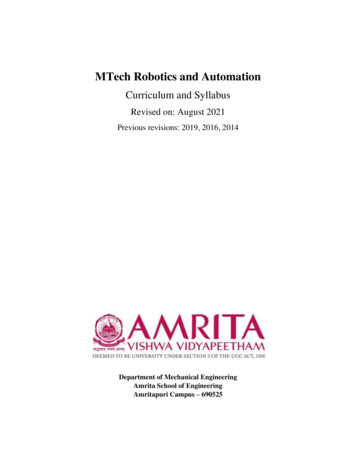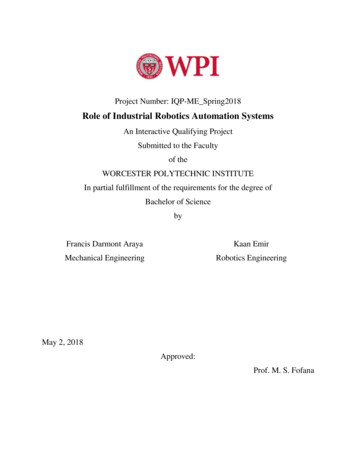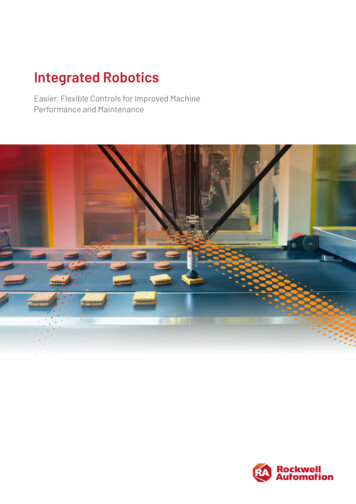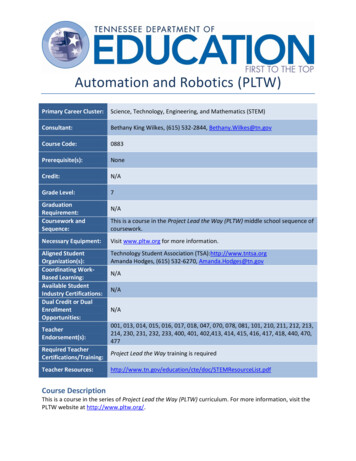
Transcription
Automation and Robotics (PLTW)Primary Career Cluster:Science, Technology, Engineering, and Mathematics (STEM)Consultant:Bethany King Wilkes, (615) 532-2844, Bethany.Wilkes@tn.govCourse Code:0883Prerequisite(s):NoneCredit:N/AGrade Level:7GraduationRequirement:Coursework andSequence:N/AThis is a course in the Project Lead the Way (PLTW) middle school sequence ofcoursework.Necessary Equipment:Visit www.pltw.org for more information.Aligned StudentOrganization(s):Coordinating WorkBased Learning:Available StudentIndustry Certifications:Dual Credit or DualEnrollmentOpportunities:Technology Student Association (TSA):http://www.tntsa.orgAmanda Hodges, (615) 532-6270, :001, 013, 014, 015, 016, 017, 018, 047, 070, 078, 081, 101, 210, 211, 212, 213,214, 230, 231, 232, 233, 400, 401, 402,413, 414, 415, 416, 417, 418, 440, 470,477Required TeacherCertifications/Training:Project Lead the Way training is requiredTeacher ResourceList.pdfCourse DescriptionThis is a course in the series of Project Lead the Way (PLTW) curriculum. For more information, visit thePLTW website at http://www.pltw.org/.
Program of Study ApplicationThese courses build knowledge and skills related to the following career clusters:1) Architecture & Construction2) Information Technology (IT)3) Manufacturing4) Science, Technology, Engineering & Mathematics (STEM)5) Transportation, Distribution, & LogisticsCourse StandardsThe course standards outlined below are the copyrighted property of Project Lead the Way. Teachersmust participate in Project Lead the Way training in order to be able to teach this course. This course isone in a series of PLTW middle school courses. The lesson numbers below reflect the recommendedsequence.Lesson 2.1 What is Automation and Robotics? (7 days)Understandings1) Automation is the use of technology to ease human labor or to extend the mental or physicalcapabilities of humans.2) Robotics is the specialized field of engineering and computer science that deals with the design,construction, and application of robots.3) The use of automation and robotics affects humans in various ways, both positively andnegatively, including their safety, comfort, choices, and attitudes about a technology’sdevelopment and use.4) Automation and robotics have had an influence on society in the past and present and willinfluence society in the future.5) Engineers, designers, and engineering technologists are in high demand for the development offuture technology to meet societal needs and wants.Knowledge and SkillsIt is expected that students will: Describe the purpose of automation and robotics and its effect on society. Summarize ways that robots are used in today’s world and the impact of their use on society. Describe positive and negative effects of automation and robotics on humans in terms of safetyand economics. Provide examples of STEM careers and the need for these professionals in our society.Lesson 2.2 Mechanical Systems (12 days)Understandings1) Energy is the capacity to do work; the use of mechanisms is necessary to transfer energy.2) Engineers and technologists design mechanisms to change energy by transferring direction,speed, type of movement, and force or torque.3) Mechanisms can be used individually, in pairs, or in systems.Page 2
Knowledge and SkillsIt is expected that students will: Use ratios to solve mechanical advantage problems. Use numerical and algebraic expressions and equations to solve real-life problems, such as gearratios. Use the characteristics of a specific mechanism to evaluate its purpose and applications. Apply knowledge of mechanisms to solve a unique problem for speed, torque, force, or type ofmotion.Lesson 2.3 Automated Systems (26 days)Understandings1) Automated systems require minimal human intervention.2) An open-loop system has no feedback path and requires human intervention, while a closedloop system uses feedback.3) Troubleshooting is a problem-solving method used to identify the cause of a malfunction in atechnological system.4) Comments do not change the way a robot behaves, but they do allow the programmer toremember the function that the code performs.5) Invention is a process of turning ideas and imagination into devices and systems.6) Some technological problems are best solved through experimentation.7) Fluid power systems are categorized as either pneumatic, which uses gas, or hydraulic, whichuses liquids. (FT Version)8) Automated systems can be powered by alternative energy sources like solar and fuel cells. (FTVersion)Knowledge and SkillsIt is expected that students will: Know the seven technological resources and how they are integrated into an open and closedloop system. Describe the purpose of pseudocode and comments within a computer program. Know how to use ratio reasoning to solve mechanical advantage problems. Design, build, wire, and program both open and closed loop systems. Use motors and sensors appropriately to solve robotic problems. Troubleshoot a malfunctioning system using a methodical approach. Experience fluid power by creating and troubleshooting a pneumatic device. (FT Version) Design, build, wire and program a system operated by alternative energy. (FT Version) Explain the roles and responsibilities of mechanical, electrical, and computer engineers whosolve robotic problems.Page 3
Design & Modeling (PLTW)Primary Career Cluster:Science, Technology, Engineering, and Mathematics (STEM)Consultant:Bethany King Wilkes, (615) 532-2844, Bethany.Wilkes@tn.govCourse Code:0783Prerequisite(s):NoneCredit:N/AGrade Level:6Graduation Requirement:N/ACoursework andSequence:This is a course in the Project Lead the Way (PLTW) middle schoolsequence of coursework.Necessary Equipment:Visit www.pltw.org for more information.Aligned StudentOrganization(s):Coordinating Work-BasedLearning:Available StudentIndustry Certifications:Dual Credit or DualEnrollment Opportunities:Technology Student Association (TSA): www.tntsa.orgAmanda Hodges, (615) 532-6270, Amanda.Hodges@tn.govN/AN/AN/ATeacher Endorsement(s):001, 013, 014, 015, 016, 017, 018, 047, 070, 078, 081, 101, 210, 211, 212,213, 214, 230, 231, 232, 233, 400, 401, 402,413, 414, 415, 416, 417, 418,440, 470, 477Required TeacherCertifications/Training:Project Lead the Way training is requiredTeacher ResourceList.pdfCourse DescriptionThis is a course in the series of Project Lead the Way (PLTW) curriculum. For more information, visit thePLTW website at http://www.pltw.org/.
Program of Study ApplicationThese courses build knowledge and skills related to the following career clusters:1) Architecture & Construction2) Information Technology (IT)3) Manufacturing4) Science, Technology, Engineering & Mathematics (STEM)5) Transportation, Distribution, & LogisticsCourse StandardsThe course standards outlined below are the copyrighted property of Project Lead the Way. Teachersmust participate in Project Lead the Way training in order to be able to teach this course. This course isone in a series of PLTW middle school courses. The lesson numbers below reflect the recommendedsequence.Lesson 1.1 What is Engineering? (7 days)Understandings1) An engineering notebook is used to record original ideas or designs and to document the designprocess related to an invention or innovation.2) A portfolio is an organized collection of best works.3) Science is the study of the natural world, while technology is the study of how humans developnew products to meet needs and wants.4) Teams of people can accomplish more than one individual working alone.5) Technological change is seen through inventions, innovations, and the evolution of technologicalartifacts, processes, and systems.6) Technology can have positive and negative social, cultural, economical, political, andenvironmental consequences.7) Engineers, designers, and engineering technologists are needed in high demand for thedevelopment of future technology to meet societal needs and wants.Knowledge and SkillsIt is expected that students will: Utilize standard procedures to use and maintain an engineering notebook. Use guidelines for developing and maintaining an engineering notebook to evaluate andselect pieces of one’s own work for inclusion in a portfolio. Describe the relationship between science, technology, engineering, and math. Identify the differences between invention and innovation. Operate as an effective member of a team to complete an investigation. Describe engineering and explain how engineers participate in or contribute to the inventionand innovation of products. Describe impacts that technology has had on society.Lesson 1.2 Design Process (5 days)Understandings1) Many different design processes are used to guide people in developing solutions to problems.Page 2
2) The design brief is a tool for defining the problem; it is an agreement between the engineer andclient.3) Engineers use design briefs to explain the problem, identify solution expectations, and establishproject constraints.4) Design teams use brainstorming techniques to generate large numbers of ideas in a shortamount of time, striving for quantity, not quality.5) A decision matrix is a tool used to compare solution ideas to the criteria so that you can selectthe best solution.Knowledge and SkillsIt is expected that students will: Describe the design process and how it is used to aid in problem solving. Describe the elements of design. Recognize design criteria and constraints. Describe the purpose and importance of working in a team. Use the design process to solve a technical problem. Apply the elements of design to the design process. Explain a design brief and apply the concept when using the design process. Operate effectively as a member of a team to complete a design project. Use a decision matrix to select the best solution to a design.Lesson 1.3 Measurement (5 days)Understandings1) In the United States, we use both Standard and Metric systems of measurement.2) Being able to measure accurately is important at school and at home, at work and whenpursuing hobbies.3) Precision measuring tools are needed for accuracy, but tools must be used correctly to ensureaccurate measurements are taken.4) Quality workmanship and accurate measurements with precise instruments are necessary tosuccessfully solve problems.Knowledge and SkillsIt is expected that students will: Select the appropriate value from a conversion chart to convert between standard andmetric units. Convert between standard and metric measurements including inches, feet, yards,millimeters, centimeters, and meters. Demonstrate the ability to measure accurately with different devices and scales using boththe standard and metric systems. Explain how to measure in different contextsLesson 1.4 Sketching and Dimensioning Techniques (6 days)UnderstandingsThe ability to create a rapid, accurate sketch is an important skill to communicate ideas.Page 3
1) Orthographic drawings of an object are used to provide information that a perspective drawingmay not be able to show.2) Engineers apply dimensions to drawings to communicate size information.Knowledge and SkillsIt is expected that students will: Summarize the reasoning for using sketching as a communication tool. Use visualization, spatial reasoning, and geometric shapes to sketch two and threedimensional shapes. Recognize thumbnail, perspective, isometric, and orthographic sketches. Recognize one and two point perspective drawings. Create thumbnail, perspective, isometric, and orthographic sketches. Accurately interpret one and two point perspective drawings. Communicate ideas for a design using various sketching methods, notes, and drafting views. Dimension an orthographic sketch following the guidelines of dimensioning.Lesson 1.5 Designing For Production (22 days)Understandings1) Simple geometric shapes are combined and joined to create a representation of an 1.object.2) Engineers use computer-aided design (CAD) modeling systems to quickly 2.generate andannotate working drawings.3) Three-dimensional computer modeling uses descriptive geometry, geometric 3.relationships,and dimensions to communicate an idea or solution to a technological problem.4) As individual objects are assembled together, their degrees of freedom are 4.systematicallyremoved.5) Engineers use a design process to create solutions to existing problems. 5.6) Teamwork requires constant communication to achieve the goal at hand. 6.7) The fabrication of a prototype is the opportunity for the designer to see the product 7.as athree-dimensional object.Knowledge and SkillsIt is expected that students will: Describe the coordinate system and how geometric shapes work together to create objects. Create a three-dimensional (3D) model of an object. Apply geometric and dimension constraints to design CAD-modeled parts. Assemble the product using the CAD modeling program. Demonstrate the ability to produce various annotated working drawings of a 3D model. Identify the difference between a prototype, a model and a mock-up. Analyze what circumstances call for the use of a prototype, a model, and a mock-up. Describe why teams of people are used to solve problems. Brainstorm and sketch possible solutions to an existing design problem. Create a decision-making matrix. Use a decision making matrix to select an approach that meets or satisfies the constraints givenin a design briefPage 4
2) Robotics is the specialized field of engineering and computer science that deals with the design, construction, and application of robots. 3) The use of automation and robotics affects humans in various ways, both positively and negatively, including their safety, comfort, choices
